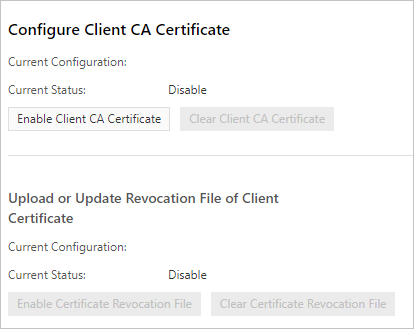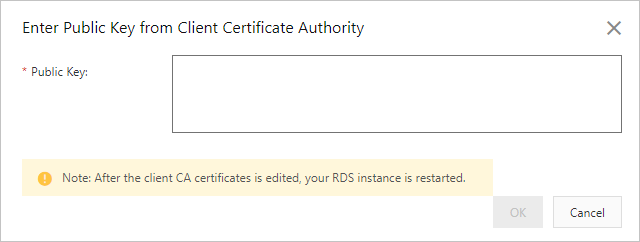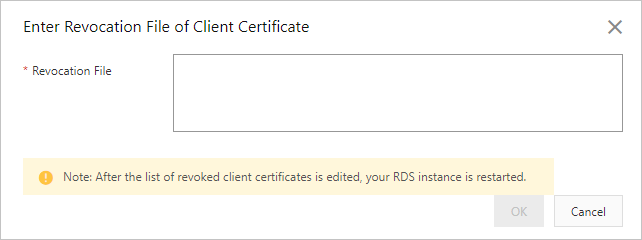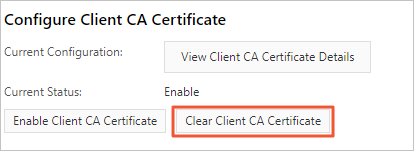This topic describes how to configure a client certificate authority (CA) certificate on an ApsaraDB RDS for PostgreSQL instance. If you use a cloud certificate or a custom certificate to enable SSL encryption for an RDS instance, a client validates the RDS instance before the client connects to the RDS instance. If you want the RDS instance to validate the client, you must also configure a client CA certificate.
Prerequisites
SSL encryption is configured, or a custom certificate is configured. For more information, see Configure SSL encryption or Configure a custom certificate.
OpenSSL is installed.
NoteLinux operating systems are provided with OpenSSL. If you use a Linux operating system, you do not need to install OpenSSL. If you use a Windows operating system, you must download the OpenSSL software package and install OpenSSL. For more information, visit the Win32/Win64 OpenSSL page.
Usage notes
After a client CA certificate is configured, you must close the existing connection and establish a new connection to make SSL encryption take effect.
When you configure a client CA certificate, change the content of the configured client CA certificate, or modify the client certificate revocation list (CRL), the RDS instance restarts. The restart process requires approximately 3 minutes. We recommend that you perform these operations during off-peak hours.
Procedure
Step 1: Create a client certificate
In this example, CentOS is used. If you use a Windows operating system, you can configure the openssl command by using the same openssl configuration that you use in CentOS.
Create a self-signed certificate and a private key for the self-signed certificate. The self-signed certificate is saved in a file named ca1.crt. The private key is saved in a file named ca1.key.
openssl req -new -x509 -days 3650 -nodes -out ca1.crt -keyout ca1.key -subj "/CN=root-ca1"Create a certificate signing request (CSR) and a private key for the client certificate. The CSR is used to request a client certificate and is saved in a file named client.csr. The private key is saved in a file named client.key.
"openssl req -new -nodes -text -out client.csr -keyout client.key -subj "/CN=<Username that is used for logons from the client>NoteIn the preceding command, the CN parameter follows the -subj parameter. You must set the CN parameter to the username of the account that is used by the client to connect to the RDS instance.
Create a client certificate. The client certificate is saved in a file named client.crt.
openssl x509 -req -in client.csr -text -days 365 -CA ca1.crt -CAkey ca1.key -CAcreateserial -out client.crt
After the preceding configuration is complete, run the ls command to view the created file.
# ls
ca1.crt ca1.key ca1.srl client.crt client.csr client.keyThe following list describes the files:
client.crt: the file that contains the client certificate
client.key: the file that contains the private key of the client certificate
ca1.crt: the file that contains the self-signed certificate
ca1.key: the file that contains the private key of the self-signed certificate
Step 2: Configure a client CA certificate
After a client CA certificate is configured, the status of the RDS instance changes from Running to Modifying SSL. After about 3 minutes, the status changes back to Running.
- Go to the Instances page. In the top navigation bar, select the region in which the RDS instance resides. Then, find the RDS instance and click the ID of the instance.
In the left-side navigation pane of the page that appears, click . On the page that appears, click the SSL tab.
Click Enable Client CA Certificate.

In the dialog box that appears, copy the content of the ca1.crt file to the Public Key field. Then, click OK. For more information about how to obtain the ca1.crt file, see Step 1: Create a client certificate.

Step 3: Connect to the RDS instance from the client
You can connect to the RDS instance from the client over SSL connections. For more information, see Connect to an ApsaraDB RDS for PostgreSQL instance over SSL connections.
Step 4: (Optional) Configure a CRL file
If you no longer need the client certificate, you can revoke the client certificate. After the client certificate is revoked, the RDS instance denies access requests from the client.
After a CRL file is configured, the status of the RDS instance changes from Running to Modifying SSL. After about 3 minutes, the status changes back to Running.
Prepare the configuration file
touch /etc/pki/CA/index.txt echo 1000 > /etc/pki/CA/crlnumberNoteIf you use a Windows operating system, you must perform the following operations:
Create a CA folder in the Installation directory of OpenSSL\bin directory.
Create a file named index.txt in the CA folder.
Run the following command by using the PostgreSQL CLI:
echo 1000 > <Installation directory of OpenSSL>\bin\CA\crlnumberModify the openssl.cnf file in C:\Program Files\Common Files\SSL\.
# Find the [ CA_default ] configuration item. dir = "<Installation directory of OpenSSL>\\bin\\CA"
Revoke the client certificate, which is contained in the client.crt file.
openssl ca -revoke client.crt -cert ca1.crt -keyfile ca1.keyNoteThe preceding command requires the self-signed certificate and the private key of the self-signed certificate. The self-signed certificate is contained in the ca1.crt file, and the private key of the self-signed certificate is contained in the ca1.key file. For more information, see the Step 1: Create a client certificate.
Create a CRL. The CRL is saved in a file named client.crl.
openssl ca -gencrl -out client.crl -cert ca.crt -keyfile ca.keyIn the left-side navigation pane of the page that appears, click . On the page that appears, click the SSL tab.
Click Enable Certificate Revocation File.

In the dialog box that appears, copy the content of the client.crl file to the Revocation File field.

Step 5: (Optional) Update the client certificate
This operation triggers a restart of the RDS instance. Proceed with caution.
On the SSL tab, click Clear Client CA Certificate. Then, click Enable Client CA Certificate.